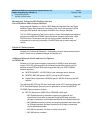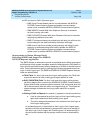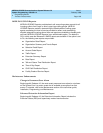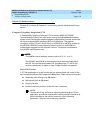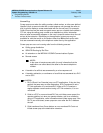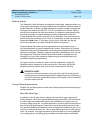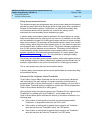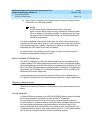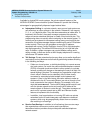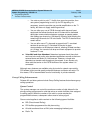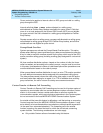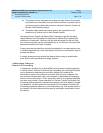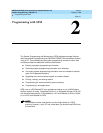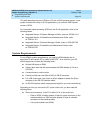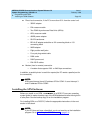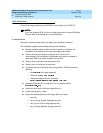
MERLIN LEGEND Communications System Release 6.0
System Programming
555-660-111
Issue 1
February 1998
Programming Basics
Page 1-75Product Enhancements
1
Available for Hybrid/PBX mode systems, the private network features of the
MERLIN LEGEND Communications System Release 6.0 provide the following
advantages for geographically dispersed organizational sites:
■ Intersystem Calling. In a private network, users on one local system can
call extensions on other systems in the network. Release 6.0 can support
2-, 3-, 4-, or 5-digit dial plans. They dial these extensions as inside calls. To
implement this function, the system manager programs the extension
ranges of remote networked switches to create a non-local dial plan. This
programming does not actually affect numbering on the remote system. To
correctly set up systems for transparent calling among non-local dial plan
extensions, the system manager assigns networking tie and/or PRI tandem
trunks to pools. Then he or she programs as many as 20 patterns,
associates with routes, Facility Restriction Levels (FRLs), digit absorption,
and digit prepending. This allows ARS-like routing of non-local dial plan
calls. In addition, system managers can control whether calling name,
calling number, or both are shown at MLX display telephone for incoming
calls across PRI tandem trunks.
■ Toll Savings. Private networked trunks may allow you to realize significant
cost savings on long-distance and toll calls by performing tandem switching
in the following two ways:
— Callers on a local system, or individuals dialing in to remote access
at a local system, can reach the public switched telephone network
(PSTN) via outside trunks connected to other systems in a private
network, avoiding toll charges or decreasing the cost of toll calls. No
special dialing is required. For example, an organization might have
a main office in Boston and a subsidiary office in New Jersey,
connected by networked private tandem trunks between two
systems. A user in the New Jersey office who wishes to make an
outside call to the 617 area code (Boston) can do so through a line/
trunk connected to the system in Boston. For example, he or she
might dial,
. The local ARS tables would route this call
over the private network trunks and use the ARS tables of the
remote system in Boston to route this call. The system managers at
each end of a private network set up ARS and Remote Access
features to implement this functionality.
— In addition, local organizations or incoming DID calls use private
networked trunks to make intersystem calls between networked
systems, which may be geographically distant from one another,
also resulting in toll savings.
■ Service Cost Savings. In addition to toll call saving, there are two ways
that organizations can save on service costs incurred from
telecommunications providers that provide public switched telephone
network access:



